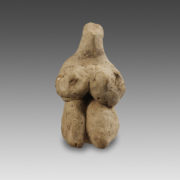Greek marble Fragment of a Kouros
Greek marble Fragment of a Kouros
The fragment belongs to a male statuette of a youth: its dimensions would have reached half life-size.
6th century B.C.
H: 19 cm
Out of stock
Product Description
The fragment belongs to a male statuette of a youth: its dimensions would have reached half life-size. Despite its current condition, this work of a remarkable quality obviously represented a kouros, as attested by the nuanced modeling of the buttocks and of the pubic area.
In the Archaic period (7th and 6th century B.C.), two types of statues dominated the panorama of sculpture in Greek art: the kore (representing a young woman, standing and clothed) and her male counterpart, the kouros. Our example depicts a young, barely pubescent man carved in a strictly frontal position, standing and most often nude: one of his legs (the left one generally) is placed a bit forward, while his arms fall along the body and his hands with clenched fists touch the thighs. Some exceptions to this type exist, but they are rare.
Most kouroi are either funeral monuments or statues dedicated in the sanctuaries they adorned. These figures were never regarded as individual portraits: they are the expression of an idealized male beauty and youth, regardless of the age of the commissioner. Furthermore, only the high-ranking classes of society would dedicate such statues. It is generally accepted that the kore type served to Greek sculptors as a basis in the learning of the rendering of garments and fabrics, and that the kouros allowed them to perfectly understand the anatomy of the human body.
Chronologically, these types of statues are documented all throughout the Archaic period, from the mid-seventh century until the early 5th century B.C.: among other examples they inspired in Classical sculpture, one can mention famous works, such as the Caryatids of the Erechtheion or the Doryphoros of Polykleitos.









